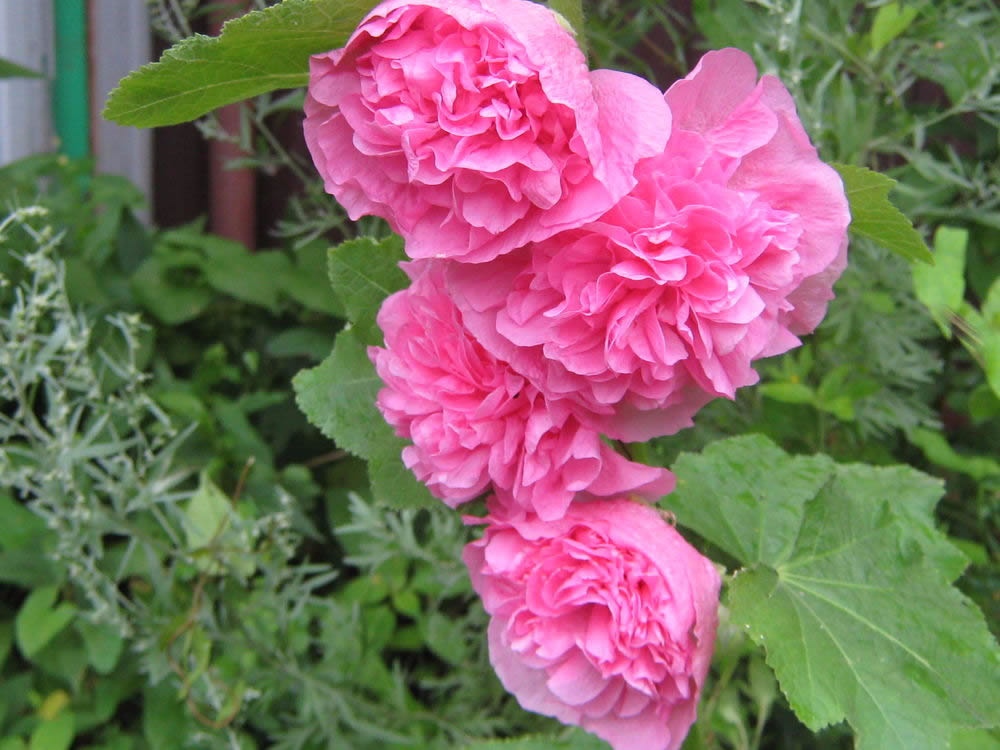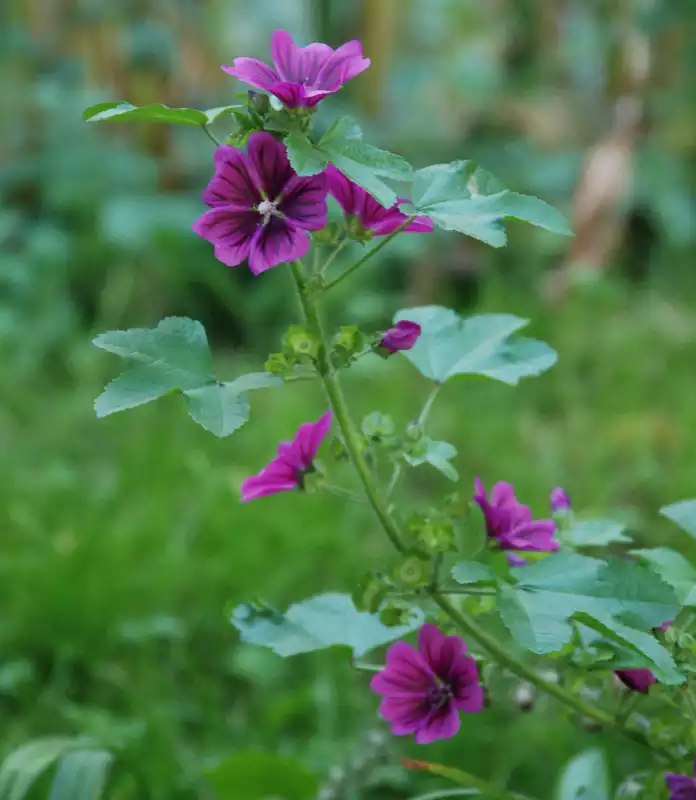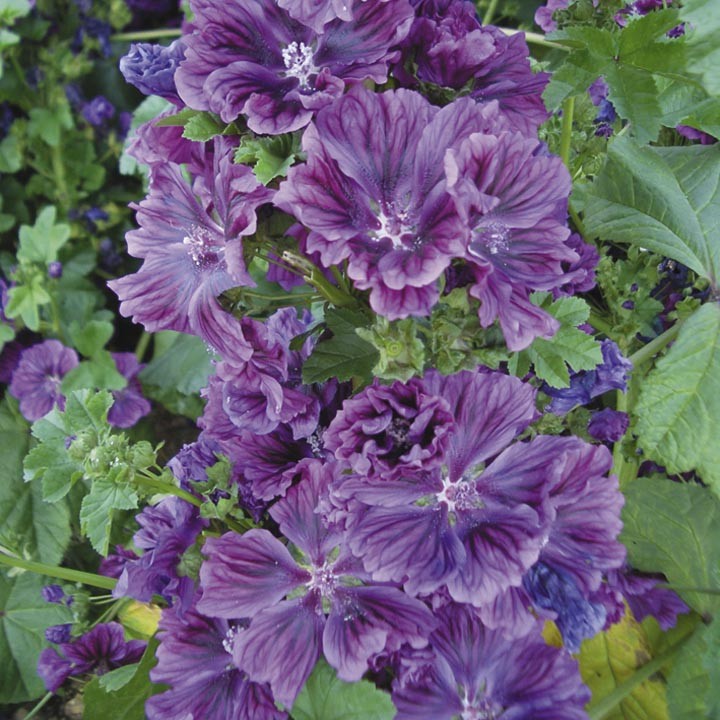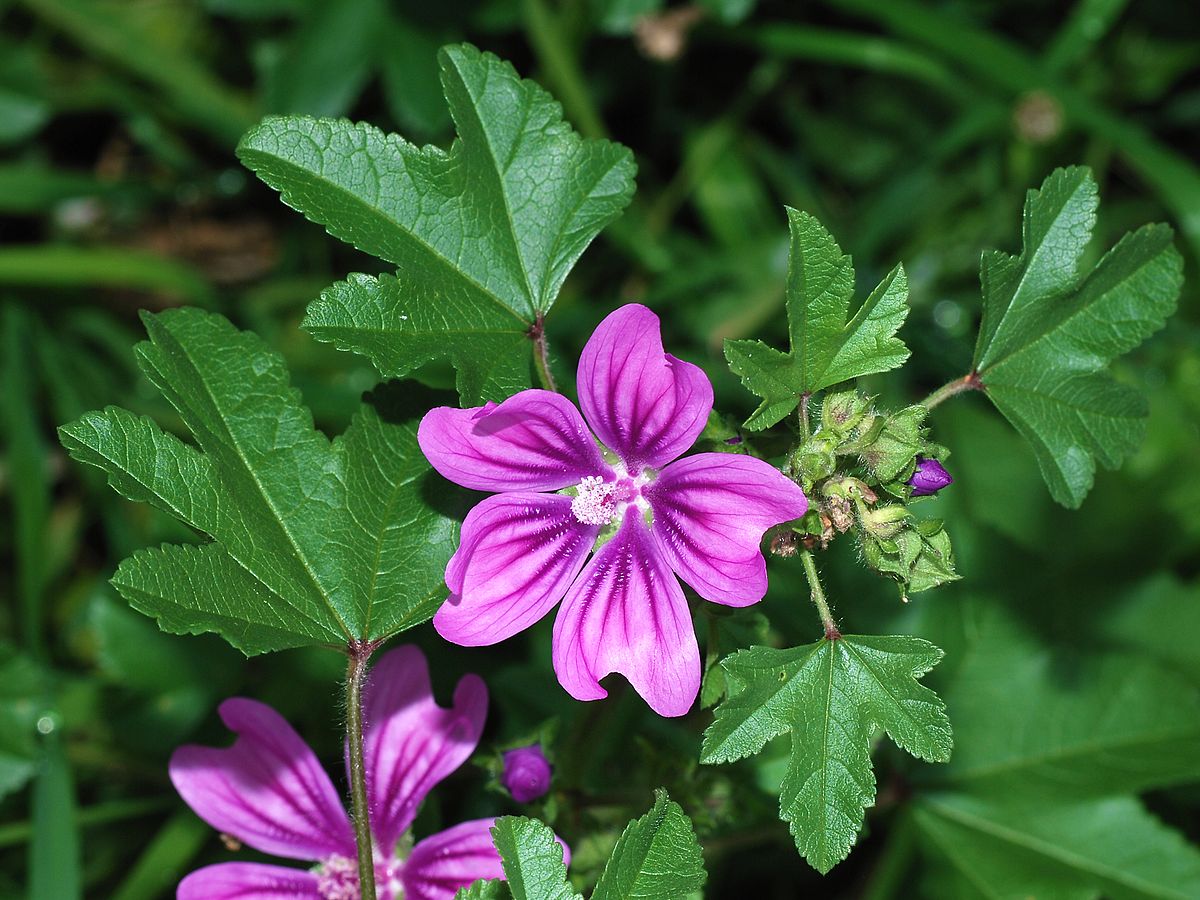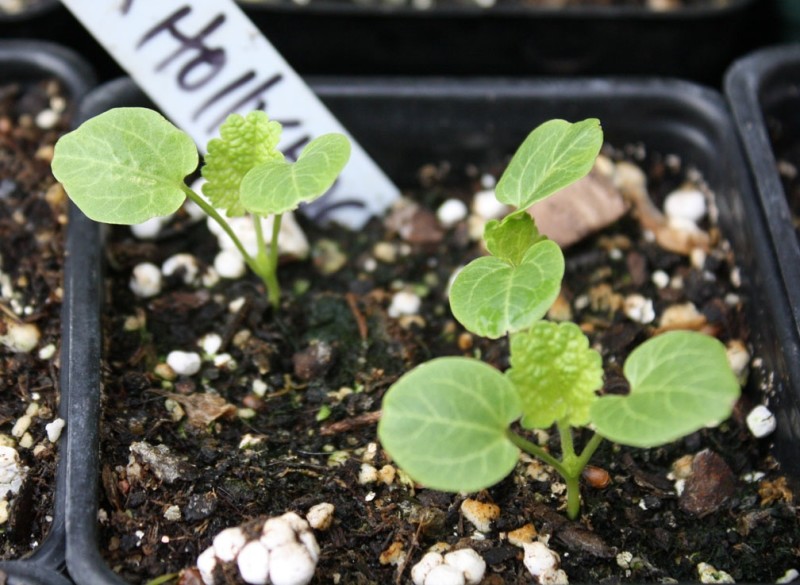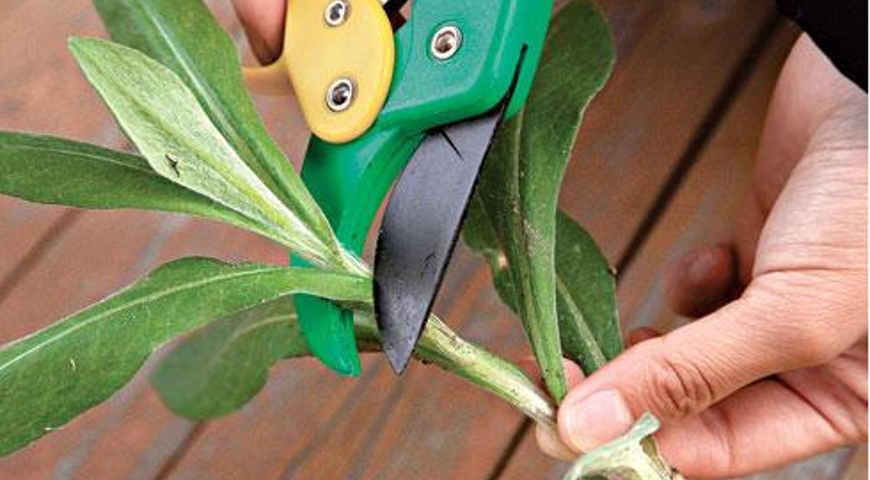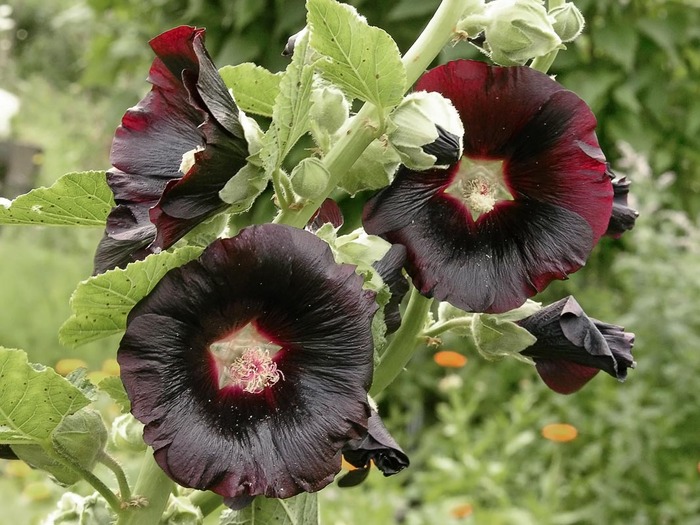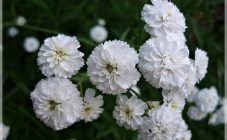Content:
Perennial mallow is one of the most popular ornamental plants in Russia and in the world. When cultivating it, it is necessary to observe a number of agrotechnical principles and recommendations, without which it will not be possible to get high-quality flowers.
Short description
Malva is a herbaceous crop belonging to the Malvov family. Plants are ubiquitous in Eurasia, North Africa, and the USA. In the wild, it grows as a weed in gardens, forests, roadsides, but it can also be grown as an ornamental crop.
Plants are most often one- or biennial with a straight, ascending or recumbent stem. Its base is usually fluffy, and the middle and top are bare. Leaves are incised, 5-7-lobed, usually pubescent. Flowers grow in leaf axils, have a variety of colors, bloom throughout the summer. The roots are powerful and oblong, strongly branched. The fruit is the schizocarp.
Popular species and varieties
The most common types of mallow include:
- Perennial musk mallow (also known as perennial musk mallow). The plant is no more than 1 m in height with large flowers that exude a powerful pleasant smell. They reach 5 cm in diameter and are white or bright pink in color. Blooms before the onset of frost. The main variety in this category is the Pink Princess.
- Forest mallow (aka wild mallow, Moorish mallow). It is the ancestor of all varieties of culture. The stem reaches a height of 120 cm, it can be either straight, ascending or lying. Its base is pubescent and covered with hairs, and the rest of it is bare. The foliage is round, cordate and attached to the stem with petioles. Flowers are enlarged in the form of a bell. The petals are heart-shaped. Flowering begins in the second year after planting in July and continues until September. The medicinal properties of wood mallow are well known all over the world, however, contraindications should be taken into account.
- Terry mallow. Plants are mainly herbaceous, reaching 2 m in length. Bloom until the second September decade. The classic variety is Mallow Garland, a biennial plant with tall decorative flowers.
- Mallow is tree-like. A perennial shrub plant about 3 m tall, popularly known as hibiscus. It has a powerful trunk with thickened branches. It begins to bloom in the first year after planting. The flowers have a lilac color, in the center there are darkish small stripes. After a certain time, it begins to bear fruit in small balls.
- Bush mallow. It has a powerful stem up to 3 m in length. The foliage is lobed, oblong, its diameter reaches 30 cm. Inflorescences are 4-5 cm in diameter, large. Their color is white, pinkish, lilac, yellow, and in some varieties black. Flowering lasts from the last decade of June to October.
- Black mallow (black stockrose). Perennial culture with a branched root system up to half a meter long. The stem of the plant is straight and elongated, reaching up to 2 m in length. Rounded leaves in the lower part of the mallow are characterized by 5-7 lobes, and at the top - 3. The branches are shortened, no more than a quarter of a meter long.The color of the flowers is deep black, due to which this variety is considered one of the most decorative among mallow.
- Mallow is pink. Usually cultivated as an annual or biennial, although in fact it is a perennial plant. The flowers are colored in various shades of pink. Plants grow up to 2.5 m in height.
- Mallow is squat. Plants with an oblong taproot, ascending or recumbent stems, which usually branch at the base. Height varies from 15 to 50 cm. The foliage is densely pubescent, fixed to the stem with elongated petioles. Blooming lasts all summer and captures the beginning of autumn.
- Round-leaved mallow (aka small mallow, undersized mallow). Bushes up to half a meter high, with an oblong tap root. Stems ascending or straight. Leaves 2-6 cm long are placed on petioles, usually glabrous, but in rare cases pubescent.
- Marsh mallow (Marshmallow, Altay). One of the most beneficial types of mallow from a medicinal point of view. The stem height ranges from 60 cm to one and a half meters. Foliage and stems are thoroughly covered with fine hairs. The root length reaches 50 cm and the diameter is 2 cm.
- Dwarf mallow. A type of plant united by a very low stem (up to half a meter). The typical variety is Majorette Mixed.
- Mallow is unnoticed. The plant is 15-40 cm high and slightly covered with hairs. The stem is ascending or straight. Leaves with 5-7 lobes are rounded on oblong petioles. The flowers are pink-white. It blooms from late spring to early autumn.
The most popular varieties of mallow are:
- Zebrina. A perennial bush up to 1 m high. Spikelets inflorescences combine several beautiful buds. Their color varies from light pinkish tones to purple with dark veins.
- Apple blossom. A perennial growing up to 2.5 m. It blooms from June to early autumn. The flowers are bright pink, about 12 cm in diameter. Heat-loving variety.
- Spring Celebrity. Perennial plantations about 70 cm in height. The plant forms flowers in white, pink and beige colors. Flowering occurs throughout the summer and in the first weeks of autumn.
- Purple velvet. Plant up to 200-250 cm high, perennial. The flowers are purple, terry, about 10 cm in diameter, collected in racemose inflorescences. Blooms in June-September.
Other popular varieties:
- Alba;
- Rondell Park;
- White Tower;
- Pink Tower, etc.
Agrotechnics of mallow
To grow this beauty on the site, you need to consider several important nuances:
Site selection
Mallow grows best if it is immediately planted in a permanent place where it will be cultivated throughout its life. Therefore, it is important to immediately find the best plot for her that will satisfy all her needs.
Mallow prefers an open area that is adequately lit by sunlight. In its absence, the stems begin to stretch towards the light and become too long, fragile and brittle. At the same time, flowering is not strong enough. The petals and stalks of mallow are at risk of being easily injured from strong winds, so care must be taken to ensure that the site is reliably protected from drafts.
Mallow grows best on fertile soils with a light composition and a reliable drainage system. In this regard, loamy soils are considered the best option. In the presence of timely and full-fledged fertilizing, mallow can be normally cultivated on soils with poor content, but the groundwater should not lie too close.
Regardless of the category of the selected plot, any of them must first be dug deeply. On problem soils, compost is recommended. If it is impossible to use it, rotted manure is allowed as an alternative.
Mallow cultivation
To get flower shoots, you can use one of 3 methods:
Seminal
Perennial mallow seeds should be planted in open ground immediately to a permanent place no earlier than late May - early June, when the risk of spring frosts disappears. At the same time, flowering, as a rule, begins next year. Seeds for sowing can be bought in specialized gardening stores and prepared by yourself, collecting them in July-August of the previous season from those plants that have already completed their flowering.
The best seed germination occurs in those that were harvested 2 years before sowing. In the first year, germinated seedlings form only rosettes of large leaves with pubescence. At the same time, a powerful root system is formed. The maturation of seedlings can be accelerated if the plants are pre-cultivated in a greenhouse.
Seeds need to ensure timely optimal watering, which will allow the first shoots to be obtained after 2-3 weeks.
Experienced flower growers usually practice sowing mallow seeds in the autumn. In this case, planting holes are dug no more than 3 cm deep, located at a distance of half a meter from each other. After sowing, the holes are covered with peat or loosened fertile soil. Before the beginning of winter, the seeds are covered with a layer of straw or fallen leaves.
Growing through seedlings
This method involves sowing seeds in early spring and cultivating them mainly indoors until mid-summer, when they reach such a state that they can be transplanted to a permanent place in the open field. Mallow reacts negatively to transplanting and does not always take root in a new site. In view of this, it is recommended to resort to the use of peat pots for the cultivation of seedlings. Seedlings can be transplanted into open ground directly in them.
Acceleration of seed germination can be ensured by pre-soaking the seeds in heated water for several hours. When sowing is done, the pots are covered with transparent glass or polyethylene film to provide a greenhouse environment for the seedlings. Additional lighting will also help accelerate seed germination.
When the plants form 3 true leaves, it is allowed to start picking. This procedure for mallow is associated with certain difficulties and provokes a slowdown in the growth of young seedlings. The plant has to be moved along with the earthen clod in order to keep the roots intact. An alternative option is more preferable, when several seeds are sown in one peat pot, and then the strongest and fully formed sprouts are left from the formed sprouts, and the rest are removed.
2 weeks before transplanting into open ground, the seedlings begin to harden. To do this, they are taken out to fresh air every day, each time increasing the time of their stay. It is best to transplant to a permanent place in early September. Seedlings in the fall will have time to form a sufficiently powerful root system, and in the winter the plantings can be covered with dry leaves or peat. With the onset of spring, the plants will immediately start growing.
Cuttings
This method is not very effective due to the poor survival of the cuttings and is usually used only by experienced growers. It is suitable for breeding varietal specimens, since it allows you to get plants with absolutely identical characteristics and characteristics to the parent.
The procedure is carried out in spring or summer. In the first case, cuttings are cut near the root of adult plants. The summer method involves harvesting cuttings from the stems.
They are cut with a sharpened pruner or a garden knife. The place of the cut on the mother plant is covered with charcoal. Cuttings are immediately placed in peat pots or a nutritious soil substrate. The soil must be constantly moistened, which can be achieved through regular irrigation. Soon, young leaves begin to form on the cuttings, which signals their successful rooting. When they start to start growing, they can be transplanted to a new location in the open ground.
Watering and feeding
Thanks to its powerful and buried root system, the plant is able to independently obtain moisture for itself, which limits the need for frequent irrigation. Instead, 1-2 irrigations are carried out per week, and in dry periods in the absence of drought - 3 irrigations.
Mallow responds positively to feeding. Organic matter is applied under it once a year, and phosphorus-potassium preparations - once every 17-20 days. During the budding period, the plantations are especially in need of fertilizing, therefore, complex fertilizer is usually applied in this phase. Throughout the growing season, compost is used as a mulching material for mallow.
Other care activities
The mallow root system lies deep in the soil, so it requires a normal supply of oxygen. In view of this, the soil surface in the bite sector should be regularly loosened. This should be done with caution, since even the slightest injury to the roots can provoke the death of the plant. Together with loosening, weeds are also removed, which can drown out the growth of mallow, especially in the first months of life.
Most mallow species are relatively tall plants. If the crop is cultivated in an area open to the wind, it should be supported. To do this, you can use fences or hedges, as well as wooden pegs 1.5 m long driven into the ground.
In Central Russia and the northern regions, it is recommended to cover plants for the winter to protect them from cold weather. Usually foliage or straw is used for this purpose. Spruce branches are also a good hiding place.
Diseases and pests
The main fungal diseases that occur on mallow are brown rust and powdery mildew. The affected parts of the plant are cut off, and the bush itself is sprayed with the appropriate fungicides. Subsequently, mallow should not be cultivated on this plot for several more years.
In waterlogged areas, mallow is often attacked by slugs. Aphids and spider mites are also found on plantations. Insecticides and folk remedies can be used against them.
Cultivating mallow in a garden or flower bed is a simple process. With a properly selected variety and type and well-designed agricultural technology, you can easily get excellent decorative plantings.

